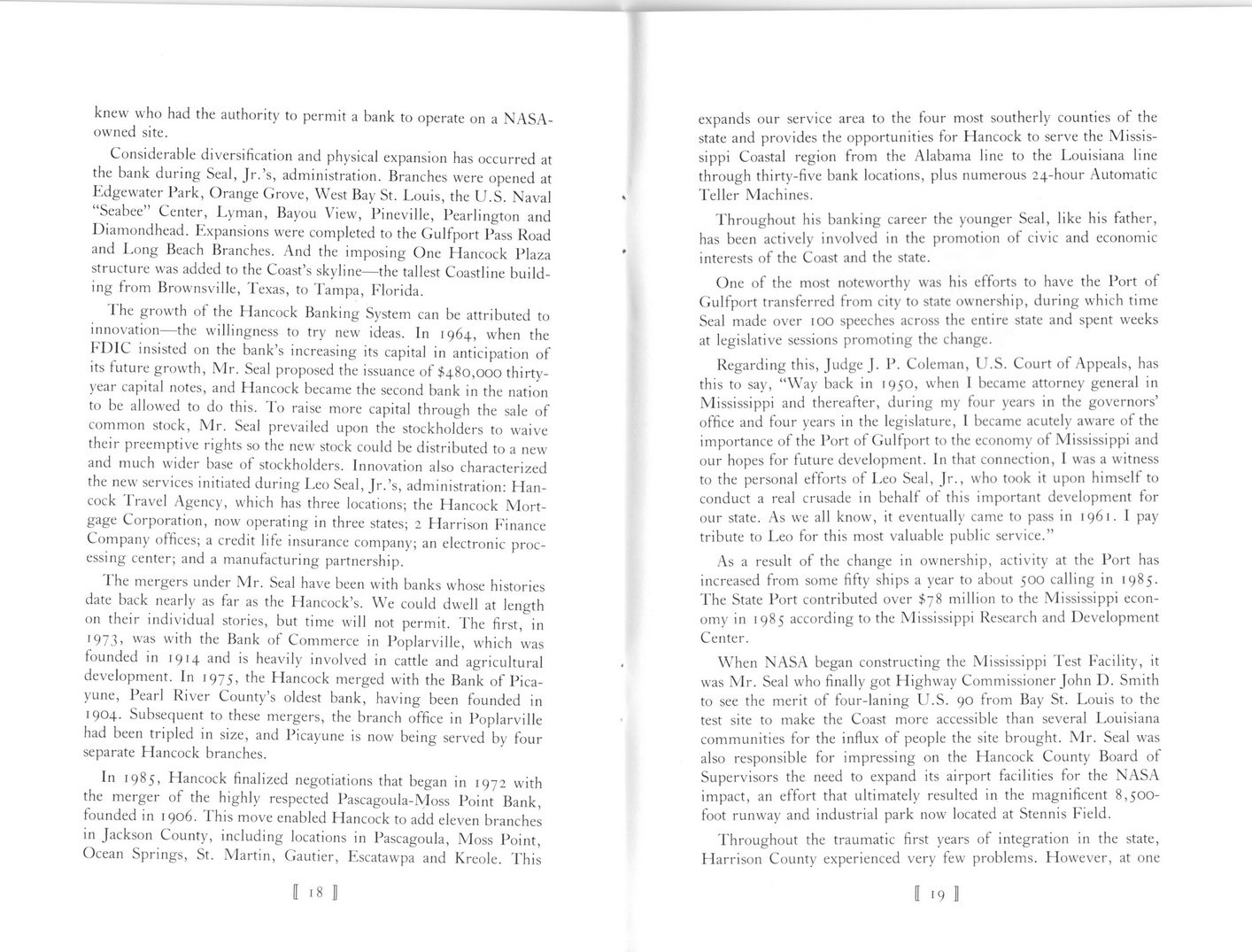This text was obtained via automated optical character recognition.
It has not been edited and may therefore contain several errors.
knew who had the authority to permit a bank to operate on a NASA-owned site. Considerable diversification and physical expansion has occurred at the bank during Seal, Jr.’s, administration. Branches were opened at Edgewater Park, Orange Grove, West Bay St. Louis, the U.S. Naval “Seabee” Center, Lyman, Bayou View, Pineville, Pearlington and Diamondhead. Expansions were completed to the Gulfport Pass Road and Long Beach Branches. And the imposing One Hancock Plaza structure was added to the Coast’s skyline—the tallest Coastline building from Brownsville, Texas, to Tampa, Florida. l'he growth of the Hancock Banking System can be attributed to innovation—the willingness to try new ideas. In 1964, when the FI)IC insisted on the bank’s increasing its capital in anticipation of its future growth, Mr. Seal proposed the issuance of $480,000 thirty-year capital notes, and Hancock became the second bank in the nation to be allow'ed to do this. To raise more capital through the sale of common stock, Mr. Seal prevailed upon the stockholders to waive their preemptive rights so the new stock could be distributed to a new and much wider base of stockholders. Innovation also characterized the new services initiated during Leo Seal, Jr.’s, administration: Hancock Travel Agency, which has three locations; the Flancock Mortgage Corporation, now operating in three states; 2 Harrison Finance Company offices; a credit life insurance company; an electronic processing center; and a manufacturing partnership. The mergers under Mr. Seal have been with banks whose histories date back nearly as far as the Hancock’s. We could dwell at length on their individual stories, but time will not permit. The first, in 1973, was with the Bank of Commerce in Poplarville, which was founded in 1914 and is heavily involved in cattle and agricultural development. In 1975, the Flancock merged with the Bank of Picayune, Pearl River County’s oldest bank, having been founded in 1904. Subsequent to these mergers, the branch office in Poplarville had been tripled in size, and Picayune is now being served by four separate Hancock branches. In 1985, Hancock finalized negotiations that began in 1972 with the merger of the highly respected Pascagoula-Moss Point Bank, founded in 1906. This move enabled Hancock to add eleven branches in Jackson County, including locations in Pascagoula, Moss Point, Ocean Springs, St. Martin, Gautier, Escatawpa and Kreole. This expands our service area to the four most southerly counties of the state and provides the opportunities for Hancock to serve the Mississippi Coastal region from the Alabama line to the Louisiana line through thirty-five bank locations, plus numerous 24-hour Automatic Teller Machines. Throughout his banking career the younger Seal, like his father, has been actively involved in the promotion of civic and economic interests of the Coast and the state. One of the most noteworthy was his efforts to have the Port of Gulfport transferred from city to state ownership, during which time Seal made over 100 speeches across the entire state and spent weeks at legislative sessions promoting the change. Regarding this, Judge J. P. Coleman, U.S. Court of Appeals, has this to say, “Way back in 1950, when I became attorney general in Mississippi and thereafter, during my four years in the governors’ office and four years in the legislature, I became acutely aware of the importance of the Port of Gulfport to the economy of Mississippi and our hopes for future development. In that connection, I was a witness to the personal efforts of Leo Seal, Jr., who took it upon himself to conduct a real crusade in behalf of this important development for our state. As w'e all know, it eventually came to pass in 1961. I pay tribute to Leo for this most valuable public service.” As a result of the change in ownership, activity at the Port has increased from some fifty ships a year to about 500 calling in 1985. The State Port contributed over $78 million to the Mississippi economy in 1985 according to the Mississippi Research and Development Center. When NASA began constructing the Mississippi Test Facility, it was Mr. Seal who finally got Highway Commissioner John D. Smith to see the merit of four-laning U.S. 90 from Bay St. Louis to the test site to make the Coast more accessible than several Louisiana communities for the influx of people the site brought. Mr. Seal was also responsible for impressing on the Hancock County Board of Supervisors the need to expand its airport facilities for the NASA impact, an effort that ultimately resulted in the magnificent 8,500-foot runway and industrial park now located at Stennis Field. Throughout the traumatic first years of integration in the state, Harrison County experienced very few problems. However, at one

Hancock Bank Leo-Seal-Leading-The-Way-(1987)-10